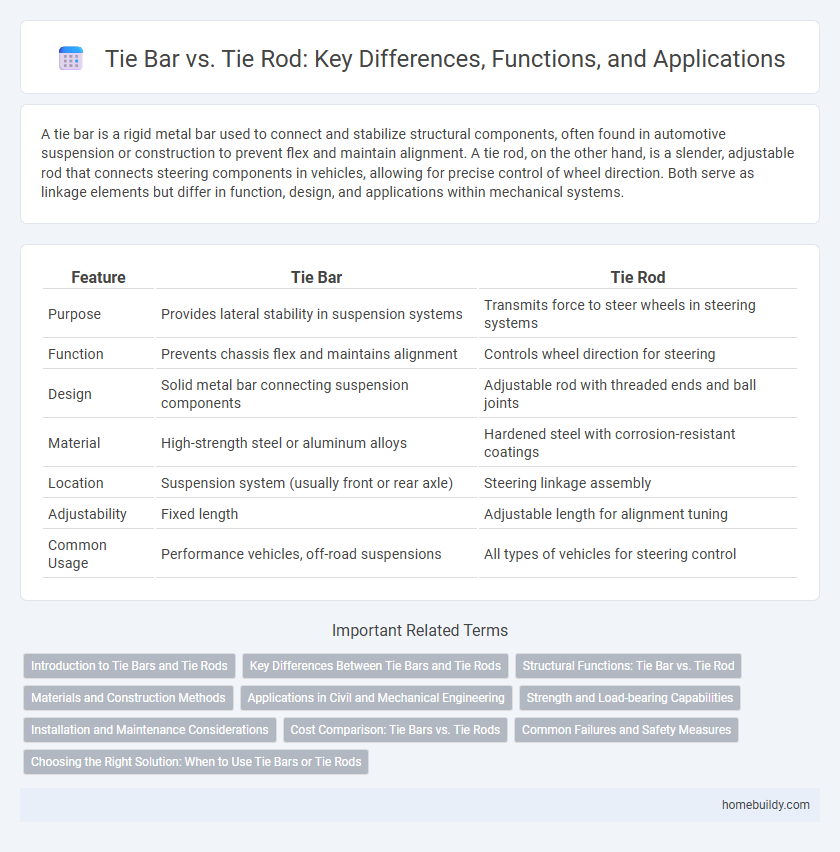A tie bar is a rigid metal bar used to connect and stabilize structural components, often found in automotive suspension or construction to prevent flex and maintain alignment. A tie rod, on the other hand, is a slender, adjustable rod that connects steering components in vehicles, allowing for precise control of wheel direction. Both serve as linkage elements but differ in function, design, and applications within mechanical systems.
Table of Comparison
| Feature | Tie Bar | Tie Rod |
|---|---|---|
| Purpose | Provides lateral stability in suspension systems | Transmits force to steer wheels in steering systems |
| Function | Prevents chassis flex and maintains alignment | Controls wheel direction for steering |
| Design | Solid metal bar connecting suspension components | Adjustable rod with threaded ends and ball joints |
| Material | High-strength steel or aluminum alloys | Hardened steel with corrosion-resistant coatings |
| Location | Suspension system (usually front or rear axle) | Steering linkage assembly |
| Adjustability | Fixed length | Adjustable length for alignment tuning |
| Common Usage | Performance vehicles, off-road suspensions | All types of vehicles for steering control |
Introduction to Tie Bars and Tie Rods
Tie bars and tie rods are critical components in automotive and machinery steering systems, each serving distinct roles in maintaining alignment and structural integrity. Tie bars typically provide a rigid connection between suspension parts to control lateral movement, whereas tie rods primarily manage steering angles by transmitting force from the steering rack to the wheels. Understanding the mechanical differences between tie bars and tie rods is essential for optimizing vehicle handling and safety.
Key Differences Between Tie Bars and Tie Rods
Tie bars primarily serve to maintain alignment and stability by linking two components and resisting tension, while tie rods adjust and control the steering mechanism by transmitting force from the steering gear to the wheel assembly. Unlike tie rods, which often feature adjustable ends to fine-tune alignment angles, tie bars are typically rigid and fixed in length. Material strength and design differ, with tie rods usually designed for dynamic movement and adjustment, whereas tie bars focus on structural rigidity and resistance to lateral forces.
Structural Functions: Tie Bar vs. Tie Rod
Tie bars primarily serve to resist lateral forces and provide stability by connecting structural elements to prevent buckling or shifting, often used in retaining walls and concrete forms. Tie rods, in contrast, function mainly in tension to hold components together, transferring tensile loads that maintain structural integrity in bridges, roofs, and machinery. Understanding the distinct roles in load transfer and stabilization ensures appropriate selection for engineering applications requiring precise structural support.
Materials and Construction Methods
Tie bars are typically made from high-strength steel or aluminum alloys, offering superior rigidity and resistance to deformation compared to tie rods, which often use steel cables or rods with less structural strength. The construction of tie bars involves precision machining and forging processes to ensure durability and load distribution, while tie rods generally rely on simpler manufacturing methods such as threading and basic forging. These material choices and construction techniques make tie bars more suitable for applications requiring enhanced stability and load-bearing capacity.
Applications in Civil and Mechanical Engineering
Tie bars provide rigid axial support in concrete structures, such as slabs and beams, preventing separation and maintaining structural integrity under tensile loads. Tie rods are tension members widely used in mechanical linkages, suspension systems, and bridge construction to resist tensile forces while allowing some flexibility. In civil engineering, tie bars strengthen reinforced concrete, whereas tie rods are preferred in mechanical engineering applications requiring adjustable tension control.
Strength and Load-bearing Capabilities
Tie bars provide superior strength and load-bearing capabilities compared to tie rods due to their solid, rigid structure that resists tension and compression forces effectively. Unlike tie rods, which are typically slender and threaded, tie bars distribute loads more evenly across connections, minimizing deformation and increasing structural stability. This makes tie bars ideal for applications requiring high-strength reinforcement in construction, automotive suspension, and industrial machinery frameworks.
Installation and Maintenance Considerations
Tie bars require precise alignment during installation to ensure optimal load distribution and prevent structural deformation, often demanding specialized tools. Maintenance of tie bars involves regular inspections for corrosion, wear, and bolt tension, with replacement intervals influenced by environmental exposure and load conditions. Tie rods, contrastingly, allow easier adjustments post-installation due to their threaded ends, facilitating tension control without disassembly but may require more frequent lubrication to prevent failure.
Cost Comparison: Tie Bars vs. Tie Rods
Tie bars typically offer a lower initial cost compared to tie rods due to simpler manufacturing and fewer materials required. Maintenance expenses for tie bars are also generally reduced because of their solid construction, which leads to enhanced durability and less frequent replacement. Conversely, tie rods may incur higher costs over time due to more complex components and potential alignment adjustments.
Common Failures and Safety Measures
Tie bars often fail due to metal fatigue and improper installation, leading to structural instability in tension and compression applications. Tie rods commonly experience failures from corrosion and bending under excessive loads, which compromise their load-bearing capacity and alignment. Safety measures include regular inspections for cracks and corrosion, applying corrosion-resistant coatings, and ensuring proper torque specifications during installation to prevent mechanical failure and maintain structural integrity.
Choosing the Right Solution: When to Use Tie Bars or Tie Rods
Tie bars provide rigid, non-flexible support ideal for maintaining fixed alignment in structural applications, while tie rods offer adjustable tensioning capabilities suited for dynamic loads and alignment corrections. Choose tie bars when stability and fixed spacing are critical, especially in machinery frames or formwork systems. Opt for tie rods when flexibility and fine-tuning are necessary, such as in suspension systems or adjustable frameworks requiring tension control.
Tie bar vs Tie rod Infographic

 homebuildy.com
homebuildy.com